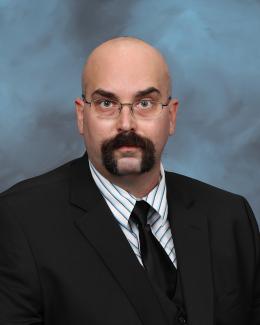Omar Demerdash, a Liane B. Russell Fellow in the Biosciences Division, combines machine learning with physics-based methods to answer questions of whether a drug is effective or not and whether protein–molecule binding modulates a disease protein’s function. His work targets diseases such as COVID-19, cancer, Alzheimer’s and Parkinson’s. Source: Carlos Jones, Oak Ridge National Laboratory
By Laurie Varma
With the rise of the global pandemic, Omar Demerdash, a Liane B. Russell Distinguished Staff Fellow at Oak Ridge National Laboratory since 2018, has become laser-focused on potential avenues to COVID-19 therapies.
Mentoring under Biosciences Division Director Julie Mitchell, Omar applies his expertise in machine learning–based methods to formulate predictions of what would make the most likely candidate drugs for disease-associated proteins.
Computational science: Protein–drug sleuth
Machine learning relies on training models of “ground truth” data sets typically consisting of examples that have been tested in the lab. Combining machine learning with physics-based methods allows Omar to answer whether a drug is effective or not, but also whether the protein–molecule binding modulates the disease protein’s function, perhaps by turning it on to make it more active or turning it off to make it less active.
“I’ve developed models that rank drugs in terms of how strongly they will bind to a protein, with the simple underlying hypothesis that the more strongly a molecule binds to a protein, the better a candidate it is for further testing in the lab, potentially becoming a drug in the end,” he said.
Making predictions is harder in the biological sciences than other research areas, Omar points out, because there are “more moving parts and many different players.” In addition, proteins can be very large, making calculations difficult.
“Let’s say we want to simulate a whole cell with all its proteins,” he said. “If we modeled it at scale with all its individual atoms, the calculations would take an unreasonably long amount of time, even if all the computing power of Summit were utilized.”
COVID-19 focus: Omar’s work goes viral
The SARS-COV-2 virus, Omar says, contains a very large protein—the spike protein we’ve all seen depicted as protruding red spikes—that comprises the principal route of entry into human cells. “Only some parts of the protein’s structure have been resolved and visualized experimentally, so size is a challenge,” he said.
Omar also points out that viruses like the SARS-COV-2 virus that causes COVID-19 have numerous proteins that can be blocked, and there are different ways to block them.
The spike protein could be blocked from binding to its putative receptor on the human cell, or the virus could be blocked at the point where it’s trying to synthesize its RNA, where its genetic material is encoded. COVID-19’s proteases could also be blocked, “throwing a monkey wrench in the virus’ replication machine,” Omar added.
Omar’s COVID-19–focused research is part of a large group effort begun at the Center for Molecular Biophysics, a collaboration between ORNL and the University of Tennessee–Knoxville that conducts research at the interface of biological, environmental, physical, computational and neutron sciences.
Since Jeremy Smith, a UT Governor’s Chair and CMB director, and Micholas Smith, also with the CMB, simulated the spike protein bound to the ACE-2 receptor, the project has expanded to simulate all COVID-19 proteins with molecular dynamics simulations.
Omar runs his models on protein–ligand complex structures generated with computational docking to screen those potential drugs. ORNL researchers collaborate with Arvind Ramanathan at Argonne National Laboratory, who develops machine learning methods to make predictions from molecular dynamics simulations, and with Colleen Johnson at UT–Memphis to validate predictions in the laboratory.
Fellowship focus broadens
Originally brought on to apply machine learning–based computational methods to predict which drugs are most promising for study as targeted protein modulators for any human disease, including cancer, Omar’s research scope has expanded to include plant–microbe interactions, with implications for understanding plant survival amid climate change and for maintaining plants as biofuel crops. He also has begun exploring the usefulness of neutron scattering data for improving modeling of proteins implicated in diseases such as Alzheimer’s and Parkinson’s.
Although Omar likes to say that any problem in chemistry or biology ultimately reduces to physics, there are inherent approximations in physics approaches that lead to decreased accuracy. “We often have to augment the physics with machine learning,” he pointed out. “I want to use the vast amounts of data biologists are generating to improve predictive power at the molecular and atomistic levels by leveraging the synergism of physics-based models, experimental data and machine learning.”
At home in East Tennessee
When not working on new drug therapies or plant–microbe dynamics, Omar likes to work out and has composed music on keyboard. He performed at open mic nights and small music festivals while he was a postdoctoral scholar at University of California–Berkeley in the mid-2000s.
“If it had to go in a genre, I guess my music would wind up being categorized as new age or ambient,” he said. Listen to a sample here.
Omar cites the friendliness and down-to-earth nature of people in East Tennessee and the warm relationships he’s developed with ORNL colleagues as among the top reasons he’s enjoying being a Russell Fellow.
According to Omar, working at ORNL has changed his research in many positive ways. “Being at a DOE lab has pushed the applied nature of my work to the foreground,” he said. “This has certainly resulted in machine learning becoming an essential part of my work in contrast to previous research positions.”
“Another great aspect is the collaborative nature of the large science focus areas and the opportunity to learn more about disciplines that I wouldn’t have known much about otherwise, such as neutron sciences and plant–microbe interfaces,” he concluded
ORNL is managed by UT-Battelle for the DOE’s Office of Science, the single largest supporter of basic research in the physical sciences in the United States. DOE’s Office of Science is working to address some of the most pressing challenges of our time. For more information, please visit https://energy.gov/science.



